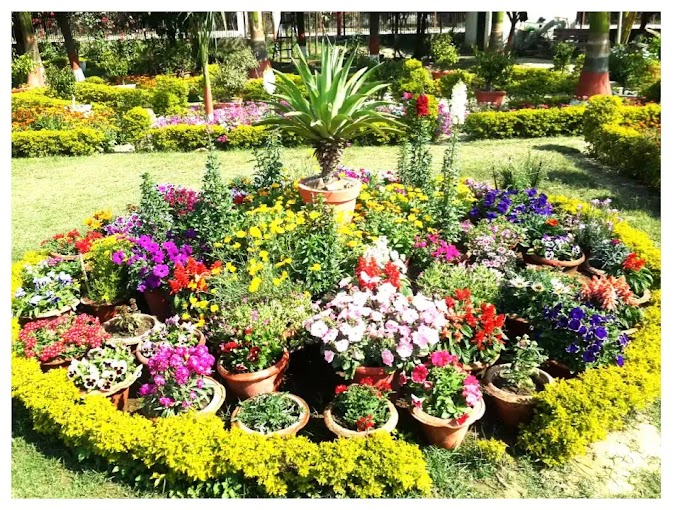Home or Kitchen Garden
Cultivation of vegetables near the home or backyard of the house to produce the vegetables for the family throughout the year is usually termed as Home or Kitchen garden. The size of the kitchen garden depends on the availability of land and size of the family. The intensive cultivation is adopted for the kitchen garden to produce fresh vegetables year round.
Principles of Kitchen Garden
- The perennials and bigger plants like papaya, lemon, lime, karonda should be grown on the north side of the garden to avoid the shade effect on other crops.
- The vegetables like cucurbits and beans should be grown around the border and allowed to spread on the fence.
- The root crops like radish, turnip, carrot, etc should be raised on ridges.
- The land should not be left vacant and intensive crop cultivation should be followed with successive or companion crops.
- The proper crop rotation must be followed in the selection of vegetable crops.
- There should be a provision of a compost pit in the corner of the kitchen garden.
- The stalking varieties of vegetables should be preferred for kitchen gardening.
- The proper planning including a selection of vegetable type and its varieties should be done before sowing to ensure a continuous supply of fresh vegetables full of nutrients without glut.
Advantages of Kitchen Garden
- It provides an opportunity for recreation and exercise to family members.
- It improves Knowledge of family members about vegetable production.
- It is the best means to convert leisure time into yields.
- It improves the standard of living by providing nutritious fresh vegetables and cutting down the expenditure on purchase of vegetables.
- It provides an opportunity for organic farming to get pesticides free vegetables.
- It creates a healthy green environment in the vicinity of home.
- It provides better pleasure, satisfaction, and reliability during eating of meals.
- The family can meet the sudden requirement of vegetables.
Market Gardening
Growing of vegetables for local or nearby markets usually 5 to 20 Km far from the vegetable farm is termed as market gardening or market garden. The distance is not a limiting factor nowadays because of road infrastructure and transportation facilities. The selection of vegetables for the market garden depends on the market demand and the value of return from the vegetables to be cultivated in comparison to other vegetables. The agro-techniques and time of sowing are selected to catch the early market or too late market to get a better price. The market gardening is done nearby the cities or towns and the farmers themselves transport the produce to the wholesale market (Mandi) of the city for selling. In addition to growers, the middleman gets a good share of the price paid by the consumers.
Advantages of Market Gardening
- Good income from small landholdings.
- A better source of income for small and marginal farmers.
- Regulation of glut by disposing of surplus produce to deficit markets.
- Availability of vegetables to city dwellers.
- Additional employment generation.
Truck Gardening
Production of only one or two vegetables relatively on a larger area in a huge amount too far from cities is termed as Truck garden, Under Truck garden the most extensive area is taken but cultivation is less intensive in comparison to market gardening. The selection of the vegetables depends on soil, climatic condition, production activities and recognition of that area for production of particular vegetables. The growers generally sell the produce to a middleman at their field as it is and the middleman harvest the produce, transport to the distant market and sell. The growers get a return as huge amounts are incurred on transport and commission to a middleman. The vegetables which can sustain long distance markets with least damage are preferred for truck gardening. Some examples of truck gardening are the cultivation of tomato in Chittoor district of Karnataka and their marketing in Bangalore, Production of Potato in Farrukhabad district of Uttar Pradesh and their marketing in Delhi. The word ‘Truck’ is derived from the French word ‘troquer’ meaning ‘to barter’ and it should not be conceived as ‘Truck’ means ‘Truck Vehicle’.
Advantages of Truck Gardening
- Commercialization of vegetable cultivation.
- Vegetables availability is possible in metropolitan cities.
- Production of vegetables at low cost.
- Additional employment in the transport and packaging sector.
- Development of cold storage industry around the cities.
Vegetable Forcing
The production of vegetables out of its normal season of cultivation comes under vegetable forcing. The vegetables are cultivated under protected conditions with high-tech knowledge, resulting in the very high cost of production. Vegetables Forcing is done for higher income consumers having more paying capacity normally residing in metropolitan cities. It is highly specialized growing of vegetables with special growing infrastructures like a poly house, glass house and net house with regulated internal conditions including temperature, humidity and light intensity. Vegetable Forcing ensures more earning by vegetable availability during the off-season. Force vegetable gardening is more popular in western and developed countries.
Advantages of Vegetable Forcing
- Supply of vegetables during the off-season.
- More return per unit area.
- Encourages development of hotel, restaurants and tourism industries.
Vegetable Garden for Processing
When a particular variety of vegetables suitable for processing is cultivated to ensure a continuous supply of quality raw materials to the processing industries then such cultivation is called vegetable garden for processing. The few suitable processing varieties of vegetables are produced in bulk and sold to the processing unit. The growers get a comparatively better price and glut is avoided in the market. The cultivation is done under the technical supervision of the processing unit using inputs and techniques provided by the processing units. The growers sell the produce to processing units as per pre-contract signed between both parties. Pre-contract between growers and processors one side solves the problems of marketing of vegetables and another side provides genuine raw materials to the processors. Cultivation of Kufri Chipsona-1 and Kufri Chipsona-2 varieties of potato for chips making, and Roma, Punjab Chhuhara and S-152 varieties of tomato for processing are the examples of vegetable gardening for processing.
Advantages of Vegetable Garden for Processing
- More return per unit area.
- Postharvest losses are reduced.
- Even highly perishable vegetables that have higher return can be grown with minimum postharvest losses.
- Additional employment generation.
- Commercialization of vegetable farming.
Floating Vegetable Garden
It is practiced in Dal Lake of Kashmir, India. The floating base is made from the local Typha grass of the Lake and organic matter like compost is spread over the base. The vegetable is grown in organic matter with necessary cultural practices and plant protection measures.
Advantages of Floating Vegetable Garden
- Water surface of the lake is converted into a farm area.
- Enhances the aesthetic appearance of the lake.
- The point of attraction and curiosity for the tourists.
Seed Production Gardening
The growing of vegetables exclusively for seeds is called seed production gardening or vegetable cultivation for seed production. It requires good knowledge and skill of seed production like varieties characteristics, mode of pollination, compatibility, isolation distance, hybridization techniques, roguing, harvesting, treatment, germination, storage and seed laws of the land.
Advantages of Seed Production Gardening
- High return.
- Additional employment generation.
- Availability of high yielding seeds for commercial cultivation of vegetables.
- Opportunity to farmers for seed replacement.







